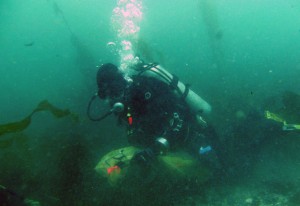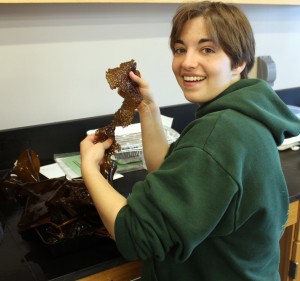Exploring Kachemak Bay's kelp forests
June 17, 2010

Carin Stephens
907-322-8730
6/17/10
Homer, ALASKA--When diver Nathan Stewart descends into one of Kachemak Bay's underwater kelp forests, he is struck by the sheer number and variety of plants and animals that live there.
"The biodiversity is incredible," says Stewart. "It's like being in an old-growth forest."
As he swims towards the seafloor, he slips through three layers of kelp forest habitat — the canopy, the mid-water layer and finally what scientists call the understory. At each layer, he finds different creatures that make their homes in the forest. At the seafloor, he lifts the kelp fronds to find a multitude of different species of snails, crabs, sponges, urchins, nudibranchs, sea stars and more.
Kelp forests provide a home for these creatures by offering food, cover from predators and structures for creatures like snails to attach themselves to. One creature, the decorator crab, uses pieces of kelp attached to its back to camouflage itself from predators. On the surface, sea otters anchor themselves above kelp forests by wrapping their bodies in the kelp fronds.
Stewart, a marine biology graduate student at the University of Alaska Fairbanks, is the teaching assistant for a kelp forest ecology course recently held at the NOAA Kasitsna Bay Laboratory, across the bay from Homer. The course is taught by UAF professor and kelp expert Brenda Konar. A serious kelp enthusiast, Konar's license plate says "KLP4ST."
There are seven students in Konar's kelp forest ecology class. Two are graduate students, and the rest are undergraduates. All of the students are certified as scientific divers with the American Academy of Underwater Sciences. The class began May 17 and continued through June 5.

Konar says that kelp forests are important because they harbor so many different organisms, including commercially important species like juvenile Pacific cod, rockfish, salmon and crab.
"Kachemak Bay is really a hot spot for the number of species we're getting within the NaGISA program," says Konar. "The number of species ranks even higher than most of the tropical places being sampled."
Each day the students break into groups and head out in rubber skiffs to sampling sites along the south shore of Kachemak Bay. Although the students are all certified scientific divers, this is their first time diving directly from a skiff.
In addition to their SCUBA gear, the divers carry a sampling bag, a clipboard with waterproof paper and a pencil attached using surgical tubing, an extra-long meter tape measure and white PVC pipe. Once at the seafloor, the students lay out the PVC pipe in a square varying in size from 25 centimeters square to one meter square.
The students write down the percentage of each type of kelp or animal and record the number of species in each square. Some students will carefully collect the animals, while others will gather the kelp from each square. They fill their bags with the kelp and the animals, and after about an hour underwater, they head to the surface.

The students' voices fill the lab, their words often punctuated by Latin names for sea slugs, sea stars and snails. They hold thick books in their hands and compare the animals they have collected to pictures in the books. If they have trouble identifying them, they take them to Konar, who aptly points them to the right page.
While one group identifies the invertebrates, the other group identifies and weighs the kelp they have collected. Stewart records the students' findings.
The sampling methods used by the students are part of what's called the "NaGISA protocol." With more than a hundred sampling sites across the globe, the NaGISA protocol ensures that the data collected for the database is the same, whether the sampling is done in Kenya or in Kachemak Bay.
After identifying and cataloging the animals, the students gently slip the creatures back into large plastic tubs filled with seawater, where visiting school groups can enjoy them.
This story was first published in The Homer News. Carin Stephens is the public information officer for the School of Fisheries and Ocean Sciences at the University of Alaska Fairbanks.


